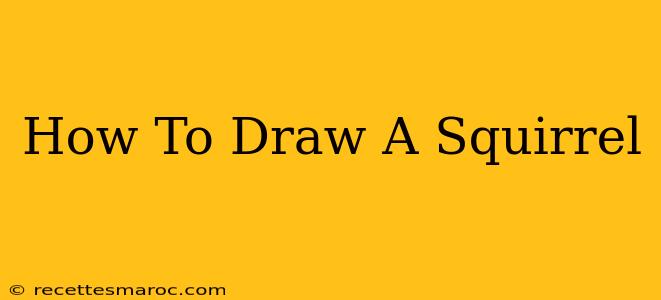Drawing a squirrel might seem daunting, but with a little practice and the right techniques, you can create a charming and realistic depiction of this bushy-tailed creature. This guide will take you through a simple step-by-step process, perfect for beginners, while also offering tips for more advanced artists looking to refine their skills. Whether you're aiming for a cute cartoon squirrel or a more detailed, lifelike portrayal, this guide has you covered!
Getting Started: Materials and Preparation
Before we begin, let's gather our supplies. You'll need:
- Pencil: A standard HB pencil is a good starting point. You might also want a 2B or 4B for shading.
- Eraser: A quality eraser is crucial for correcting mistakes. A kneaded eraser is particularly useful for lifting light pencil marks.
- Paper: Use paper suitable for drawing, such as sketch paper or drawing paper.
- Sharpener: Keep your pencil sharp for clean lines.
- Optional: Colored pencils, crayons, or markers for adding color to your finished drawing.
Step-by-Step Guide to Drawing a Squirrel
Let's break down the process into manageable steps:
Step 1: Sketching the Basic Shapes
Begin by sketching the basic shapes that make up the squirrel's body. Think of simple forms like:
- Circle: For the head.
- Oval: For the body.
- Smaller oval: For the bushy tail.
Lightly sketch these shapes, leaving room for adjustments. Don't worry about perfection at this stage; this is just a foundation.
Step 2: Refining the Body and Head
Connect the head and body ovals with a smooth curve to create the neck. Refine the oval for the body, making it slightly wider at the shoulders and tapering towards the hind legs. Add a smaller oval or elongated teardrop for the squirrel's nose.
Step 3: Adding the Details
Now, it's time to add the details:
- Ears: Draw two small, pointed ears on top of the head.
- Eyes: Add two small, dark circles for the eyes.
- Nose and Mouth: Refine the nose and add a tiny mouth line below it.
- Legs and Feet: Sketch four small legs, each ending in tiny paws with claws.
- Tail: Fluff out the tail, adding individual strands of fur. The tail should be a significant portion of the squirrel's overall length.
Step 4: Refining the Fur and Shading
This is where your drawing comes to life. Use short, light strokes to create the texture of the fur. Pay attention to the direction of the fur growth. Add shading to create depth and dimension. Darker areas will be around the eyes, nose and under the body.
Step 5: Adding Final Touches and Background (Optional)
Once you're happy with the shading, you can add final touches like more defined claws, whiskers, or details on the fur. You can also add a background to your drawing, such as a tree branch or a nut.
Tips for Advanced Artists
- Reference Images: Use reference photos of squirrels to observe their anatomy and postures accurately.
- Different Poses: Experiment with different poses – squirrels can be dynamic!
- Varying Fur Textures: Pay attention to the different textures of fur on different parts of the body (e.g., smoother on the face, bushier on the tail).
- Advanced Shading Techniques: Explore techniques like hatching, cross-hatching, and blending to create more realistic shading.
Conclusion: Practice Makes Perfect
Drawing a squirrel takes patience and practice. Don't be discouraged if your first attempt isn't perfect. Keep practicing, experiment with different styles, and most importantly, have fun! With time and dedication, you'll be able to create stunning and expressive drawings of these charming creatures. Remember to search for "squirrel drawing tutorial" for more visual learning.

